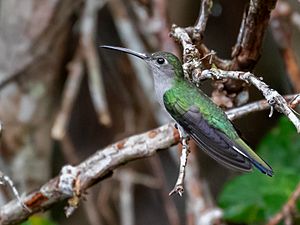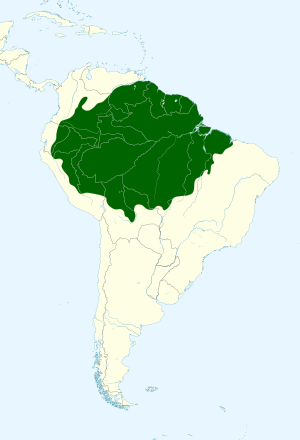Grey-breasted sabrewing facts for kids
Quick facts for kids Grey-breasted sabrewing |
|
|---|---|
 |
|
| Grey-breasted sabrewing in Amazonas, Brazil. | |
| Conservation status | |
| Scientific classification | |
| Genus: |
Campylopterus
|
| Species: |
largipennis
|
 |
|
The grey-breasted sabrewing (Campylopterus largipennis) is a beautiful type of hummingbird. These tiny birds are known for their fast wings and love for flower nectar. You can find them in parts of South America. This includes countries like Bolivia, Brazil, Ecuador, the Guianas, Peru, and Venezuela.
Contents
About the Grey-breasted Sabrewing's Name
Scientists give every animal a special name. This helps everyone know exactly which animal they are talking about. The grey-breasted sabrewing got its scientific name, Campylopterus largipennis, a long time ago.
The first part of its name, Campylopterus, comes from ancient Greek words. Kampulos means "curved" or "bent." Pteros means "winged." This refers to the shape of their wings. The second part, largipennis, comes from Latin words. Largus means "ample" or "large." Pennis means "winged." So, its name basically means "curved, large-winged."
Scientists sometimes disagree on how many types of grey-breasted sabrewings there are. Some say there are three main groups, called subspecies. Others think there are only two. These groups are slightly different depending on where they live.
What Does the Grey-breasted Sabrewing Look Like?
The grey-breasted sabrewing is a fairly large hummingbird. It grows to be about 12 to 15 centimeters (5 to 6 inches) long. Males are a bit heavier than females. Males weigh about 9 to 10 grams, and females weigh about 7 to 8 grams. That's about the weight of a few paper clips!
Both male and female sabrewings look very similar. Their beak is slightly curved downwards. The top part of the beak is black. The bottom part is pinkish with a black tip.
Their top feathers are a shiny dark green. Their belly and chest are dark gray. They also have a small white spot right behind each eye. The two middle feathers of their tail are green. The other tail feathers are bluish-black on the inside and white on the outside. Some types of sabrewings have gray tips on their outer tail feathers instead of white.
Where Do Grey-breasted Sabrewings Live?
These hummingbirds live in different parts of South America.
- One group lives in eastern Venezuela, the Guianas, and northern Brazil.
- Another group is found in northeastern Brazil.
- A third group lives from eastern Colombia and northwestern Brazil. They also live south through eastern Ecuador and Peru into northern Bolivia.
They like to live in humid forests. This includes old, untouched forests and forests that are growing back. They also live in clearings within these forests and in plantations. You can usually find them at heights between 100 and 800 meters (about 330 to 2,600 feet) above sea level.
Grey-breasted Sabrewing Behavior
Movement and Home
The grey-breasted sabrewing does not migrate. It stays in the same area all year long. This means it is a resident bird in its habitat.
How They Find Food
Grey-breasted sabrewings love to drink nectar from many different kinds of flowers. They usually look for food at low to medium heights in the forest. Male sabrewings often protect their favorite feeding spots. They don't just eat nectar. They also catch small insects. They do this by flying out from a perch, grabbing the insect, and then returning to their spot. This is called "hawking."
Reproduction and Nests
The breeding season for these hummingbirds changes a lot depending on where they live. They build a cup-shaped nest. It is made of soft moss and lined with fluffy seed material. They decorate the outside of the nest with small pieces of lichen.
They often place their nest like a saddle on a horizontal tree branch. Sometimes, they attach it to hanging twigs. They usually build their nests near waterfalls or running streams. The nests are typically about 1 meter (3 feet) off the ground. Scientists are still learning about how long it takes for their eggs to hatch and for the young birds to leave the nest.
What Do They Sound Like?
The grey-breasted sabrewing makes short calls that sound like "chik" or "trzik." Sometimes, they make a faster, stuttering sound. What people think is their song is often just these same calls. But they are delivered in a more regular, continuous series.
Status and Protection
The IUCN (International Union for Conservation of Nature) has looked at the grey-breasted sabrewing. They have decided that it is a species of "Least Concern." This means it is not currently in danger of disappearing.
There are many grey-breasted sabrewings in the world. Scientists estimate there are at least three million mature birds. However, this number is thought to be slowly going down. Their forest homes are slowly being changed. People are using the land for farming, building cities, and mining.
See also
 In Spanish: Ala de sable gris para niños
In Spanish: Ala de sable gris para niños


